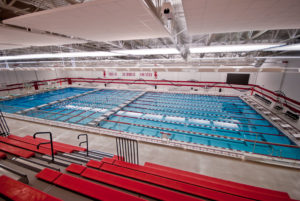A Perspective on Pools
-
Category
Studio-K12, Studio-Community, Innovation -
Posted By
Tom Neff -
Posted On
Oct 24, 2017
At Schmidt Associates, we know pools are community assets—no matter their location. Today’s generation is able to experience pools built for specific purposes to maximize the experience and benefit. There are four basic categories of pools: competition and diving, instructional, recreational, and therapy pools.
- Competition and diving pools are designed and constructed to meet strict state and national guidelines that regulate the length of swimming lanes, the depth of the water, the height of the diving boards and starting blocks, the illumination levels, the air quality, and the temperature and chemical composition of the water. Competition pool and diving pools are either in the same pool tank with different depths of water, or as separate tanks in the same facility.
- Instructional pools are usually part of an overall aquatics program that feeds into a competition swimming program. This type of pool can be adapted from a competition pool to maximize investment. Typically, a “shallow” entry point to accommodate instruction can be located in the middle of the pool. Depths associated with racing dives from the “ends” of the competition pool are suggested at seven feet. If there is sufficient room around the pool, there could also be an adjacent entry pool that is outside of the defined swimming lanes.

Munster High School Competitive and Instructional Pool
- Recreational pools place the emphasis on “fun”. In these facilities, competition components are not primary functions. Though some may have lap pool components—water slides, spray features, and lazy rivers are the primary features. Also different from competition and instructional facilities, recreational pools are warmer environments. A higher rate of water filtration and air circulation are also found in recreational pools.
- Therapy pools have very specific applications for physical or occupational therapies. Assisted access and water jets are key components, as well as in-pool windows for observation. This allows therapists standing outside of the pool to monitor patients as necessary. Water temperatures are usually the highest in these types of facilities.
Any of these pool types could be indoor or outdoor—but in Indiana’s climate, an indoor facility is the only year-round option. Schmidt Associates delivers responsive, aquatic environments to meet the most demanding aquatic challenges—no matter the type of pool. From the fastest, smoothest, most competitive water, to the relaxing swish of a lazy river, Schmidt Associates has 40 years of experience in exceeding expectations, creating environments to break records and stretch smiles, and providing the backgrounds for the memories that last a lifetime.
Take a look at all of our aquatics experience:




